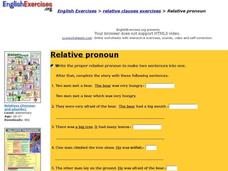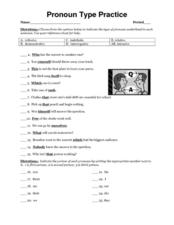Curated OER
Relative Pronouns in Spanish
After reading up on relative pronouns and antecedents, Spanish learners can use the menu to navigate the material on the webpage. Each pronoun is paired with an explanation and examples. Within the provided presentation, you will find...
Curated OER
Relative Pronouns--Omission
In this grammar worksheet, students choose whether to omit or keep the relative pronoun in ten sentences. Students check their answers when completed.
K12 Reader
Relative Pronouns
Do your learners know what relative pronouns are? How about relative clauses? They can practice identifying both of these by completing this worksheet. There are 25 sentences here for pupils to work with.
Curated OER
Non-Defining Relative Pronouns Exercise
Writing flows better with complex and compound sentences. Teach your learners how to combine sentences using relative clauses. This worksheet has 10 questions, but there are no examples provided. Consider providing at least a few...
University of North Carolina
Relative Clauses
Knock, knock. Who's there? To. To who? No! To whom. Knowing when to use who versus whom is just one of the many topics covered on a handout about relative pronouns. Writers discover how to incorporate words such as whose, that, which,...
Curated OER
Relative Pronouns
What does a relative pronoun have to agree with in a sentence? If you said the its antecedent, you're right! Read the short explanation and study the examples at the top of the page. Then, decide which verb form matches the relative...
Pearson
Adjective Clauses
Encourage the knights and princesses in your class to practice adjective clauses and relative pronouns in a fairy tale-themed presentation! Several slides review the structure of sentences with adjective clauses before prompting your...
Curated OER
English Exercises: Relative Pronouns
In this online, interactive instructional activity, emerging grammarians respond to seven fill in the blank questions that require them to use relative pronouns. After completing the exercise, they can submit their answers for...
Oxford University Press
Language Focus: Interrogative and Demonstrative Pronouns
Work on who, what, where, and how with several grammar activities. Additionally, kids complete sentences with demonstrative (relative) pronouns based on whether items are close or far away.
Curated OER
Scrutinizing Stand-Ins: Working With Nouns and Pronouns
Use the Schoolhouse Rock episode, "Rufus Xavier Sarsaparilla," to introduce a study of pronouns. Learners consider antecedents, cases (nominative, objective and possessive), as well as types of pronouns, and then craft sentences using...
Rosetta Stone
Absolute Possessive Pronouns
Pronouns are meant to replace nouns in a sentence, but don't replace this resource so easily! A collection of worksheets challenges young grammarians with fill-in-the-blanks, word searches, and sentence diagramming.
Curated OER
Reference Packet: Pronouns
Pronouns, pronouns, pronouns! Review all of the different types of pronouns, and complete several practice opportunities. Read through the information with your class before sending them off to work on the packet independently.
English Exercises
Relative Pronouns
Provide your independent learner with some practice on relative pronouns. A brief explanation of when who, which, and whose is provided at the top of the screen before learners can scroll to two exercises. The first has them choose the...
Curated OER
Relative Pronouns and Adverbs
Take your class to the computer lab to give them some independent practice. Relative pronouns and adverbs are the focus here, so learners will grapple with when to use who, which, that, whose, and where. There are 19 multiple choice...
Curated OER
English Exercises: Relative Clauses
Four short exercises give learners the opportunity to review relative clauses including should, might, who, which, or that. They complete a fill in the blank activity first before forming complete sentences from a collection of phrases...
Nosapo
Family Titles, Pronouns, Writing about a Person
How is your grandmother related to you? How is your cousin related to your grandmother? Learn about family relationships and pronouns with an activity that guides pupils to write two short narratives about members of their families.
Curated OER
Relative Clauses
Print this series of exercises for your emerging grammarians. There are four exercises provided here to assess their knowledge of relative pronouns and clauses. The exercises are rather lengthy, so consider dividing the assignment...
Curated OER
Not So Personal Pronouns
There are six types of pronouns to explore! Put on your thinking hat and read about each type: demonstrative, indefinite, intensive, interrogative, and reflexive. This learning exercise comes with two pages of explanations and examples,...
K12 Reader
Special Singular Pronouns
As everybody knows, pronouns must match their antecedents. Except for those special ones like everybody, neither, one and several others. These exceptions are the focus of a short instructional activity that first models the...
K12 Reader
Pronouns and Antecedents
Practice the basics of pronoun-antecedent agreement by assigning this exercise. Class members identify both the pronoun and the antecedents in ten sentences.
Curated OER
Relative Pronouns
In this online grammar worksheet, students select a relative pronoun to complete each of the 15 sentences.
Curated OER
Pronoun Type Practice
Explore the world of pronouns; it's a lot bigger than you think! With reflexive, indefinite, relative, demonstrative, interrogative, and intensive pronouns, you have to give your class clear, easy to understand explanations. After...
Cloud Front
Grammar Camp Worksheet Packet
Whip your students' grammar skills into shape with this series of practice worksheets. Touching on all eight parts of speech, these exercises challenge learners to identify the relationships between different words...
K12 Reader
Choose the Pronoun
Make sure those pronouns and antecedents match up! For this exercise, learners complete eight sentences by selecting the correct pronouns.

























